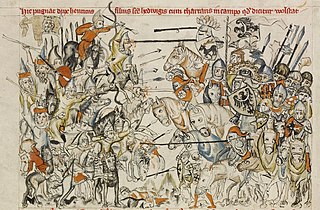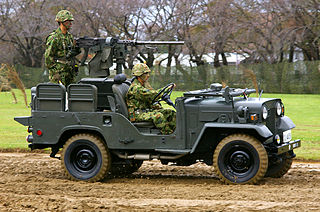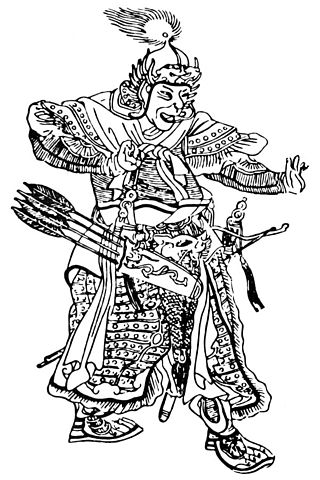
An ambush is a surprise attack carried out by people lying in wait in a concealed position. The concealed position itself or the concealed person(s) may also be called an "ambush". Ambushes as a basic fighting tactic of soldiers or of criminals have been used consistently throughout history, from ancient to modern warfare.

Combined arms is an approach to warfare that seeks to integrate different combat arms of a military to achieve mutually complementary effects—for example, using infantry and armour in an urban environment in which each supports the other.

The Battle of Legnica, also known as the Battle of Liegnitz or Battle of Wahlstatt, was fought between the Mongol Empire and combined European forces that took place at the village of Legnickie Pole (Wahlstatt), approximately 10 kilometres (6 mi) southeast of the city of Legnica in the Duchy of Silesia on 9 April 1241.
A frontal assault is a military tactic which involves a direct, full-force attack on the front line of an enemy force, rather than to the flanks or rear of the enemy. It allows for a quick and decisive victory, but at the cost of subjecting the attackers to the maximum defensive power of the enemy; this can make frontal assaults costly even if successful, and often disastrously costly if unsuccessful. It may be used as a last resort when time, terrain, limited command control, or low troop quality do not allow for any battlefield flexibility. The risks of a frontal assault can be mitigated by the use of heavy supporting fire, diversionary attacks, the use of cover, or infiltration tactics.

Hit-and-run tactics are a tactical doctrine of using short surprise attacks, withdrawing before the enemy can respond in force, and constantly maneuvering to avoid full engagement with the enemy. The purpose is not to decisively defeat the enemy or capture territory but to weaken enemy forces over time through raids, harassment, and skirmishing and limiting risk to friendly forces. Such tactics can also expose enemy defensive weaknesses and achieve a psychological effect on the enemy's morale.

Subutai was a Mongol general and the primary military strategist of Genghis Khan and Ögedei Khan. Subutai ultimately directed more than 20 campaigns, during which he conquered or overran more territory than any other commander in history as part of the expansion of the Mongol Empire, the largest contiguous empire in human history. He often gained victory by means of sophisticated strategies and routinely coordinated movements of armies that operated hundreds of kilometers apart from each other. Subutai is known for the geographical diversity and success of his expeditions, which took him from central Asia to the Russian steppe and into Europe. Subutai is regarded as one of the greatest military commanders in history, the single greatest in Mongolian history, and as the most talented general of Ögedei Khan.

Maneuver warfare, or manoeuvre warfare, is a military strategy which emphasizes movement, initiative and surprise to achieve a position of advantage. Maneuver seeks to inflict losses indirectly by envelopment, encirclement and disruption, while minimizing the need to engage in frontal combat. In contrast to attrition warfare where strength tends to be applied against strength, maneuver warfare attempts to apply strength against weakness in order to accomplish the mission.
Jebe was one of the most prominent Noyans (generals) of Genghis Khan. He belonged to the Besud clan, part of the Taichud tribe, which was under Targudai Khiriltug's leadership at the time of Genghis Khan. Even though Jebe was originally an enemy soldier, Genghis Khan recruited him and turned him into one of his greatest generals. Jebe played an important role in helping to expand the territory of Genghis Khan's empire. Despite playing a large role as a general for Genghis Khan, there are relatively few sources or biographies about his life. Jebe has been described as "the greatest cavalry general in history" for his unorthodox and daring maneuvers.

A rout is a panicked, disorderly and undisciplined retreat of troops from a battlefield, following a collapse in a given unit's command authority, unit cohesion and combat morale.

During the Mongol invasions and conquests, which began under Genghis Khan in 1206–1207, the Mongol army conquered nearly all of continental Asia, including parts of the Middle East, and parts of Eastern Europe. The efforts of Mongol troops and their allies enabled the Mongol Empire to become the contemporarily largest polity in human history. Today, the former Mongol Empire remains the world's largest polity to have ever existed in terms of contiguous land area and the second-largest polity overall, behind only the British Empire.

The Byzantine army evolved from that of the late Roman period taking as leading models and shaping itself on the late Hellenistic armies, but it became considerably more sophisticated in strategy, tactics and organization. The language of the army was still Latin, although later Greek dominated, as it became the official language of the entire empire. Unlike the Roman legions, its strength was in its cavalry, especially the armoured cataphracts, which evolved from the clibanarii of the late empire. Infantry were still used but mainly as a base of maneuver for the cavalry, as well as in specialized roles. Most of the foot-soldiers of the empire were the armoured skutatoi and later on, kontarioi, with the remainder being the light infantry and archers of the psiloi. The Byzantines valued intelligence and discipline in their soldiers far more than bravery or brawn. The "Ρωμαίοι στρατιώται"(rōmaíoi stratiōtai) were a loyal force composed of citizens willing to fight to defend their homes and their state to the death, augmented by mercenaries. The training was very much like that of the legionaries, with the soldiers taught close combat techniques with their swords, spears and axes, along with the extensive practice of archery.

For much of history, humans have used some form of cavalry for war and, as a result, cavalry tactics have evolved over time. Tactically, the main advantages of cavalry over infantry were greater mobility, a larger impact, and a higher riding position.

In military tactics, a flanking maneuver is a movement of an armed force around an enemy force's side, or flank, to achieve an advantageous position over it. Flanking is useful because a force's fighting strength is typically concentrated in its front, therefore, to circumvent an opposing force's front and attack its flank is to concentrate one's own offense in the area where the enemy is least able to concentrate defense.
A feigned retreat is a military tactic, a type of feint, whereby a military force pretends to withdraw or to have been routed, in order to lure an enemy into a position of vulnerability.
Swarming is a battlefield tactic designed to maximize target saturation, and thereby overwhelm or saturate the defences of the principal target or objective. Defenders can overcome attempts at swarming by launching counter-swarming measures that are designed to neutralize or otherwise repel such attacks.
The hammer and anvil is a military tactic involving the use of two primary forces, one to pin down an enemy, and the other to smash or defeat the opponent with an encirclement maneuver. It may involve a frontal assault by one part of the force, playing a slower-moving or more static role. The second phase involves a more mobile force that maneuvers around the enemy and attacks from behind or the flank to deliver a decisive blow.
The Battle of Kherlen took place between the Eastern Mongols and Ming China at the banks of Kherlen River (Kerulen) in the Mongolian Plateau on 23 September 1409.

The first Battle of Lechfeld, fought on 12 June 910, was an important victory by a Hungarian army over the combined forces of East Francia and Swabia (Alamannia) under the nominal command of Louis the Child. Located approximately 25 km (15.53 mi) south of Augsburg, the Lechfeld is the floodplain that lies along the river Lech. At this time the Grand Prince of the Hungarians was Zoltán, but there is no record of him taking part in the battle. After the battle, the victorius Hungarians broke into Franconia for the first time. On 22 June in Franconia, the same Hungarian army defeated a united army of the duchies of Franconia, Lotharingia and Bavaria in the Battle of Rednitz. The Bavarian, Frankish, Swabian and Saxonian duchies became taxpayers of the Hungarians. As consequence of this victory, in the next year, Hungarian attacks launched from the Carpathian Basin crossed the Rhine for the first time in 911.
In military tactics, a flanking maneuver, or flanking manoeuvre, is an attack on the sides of an opposing force. If a flanking maneuver succeeds, the opposing force would be surrounded from two or more directions, which significantly reduces the maneuverability of the outflanked force and its ability to defend itself.














